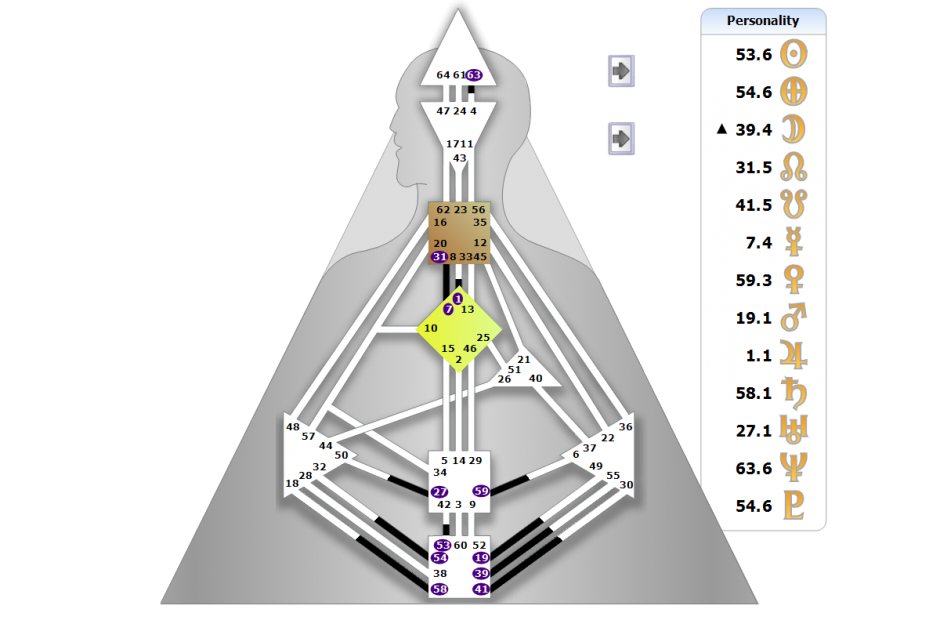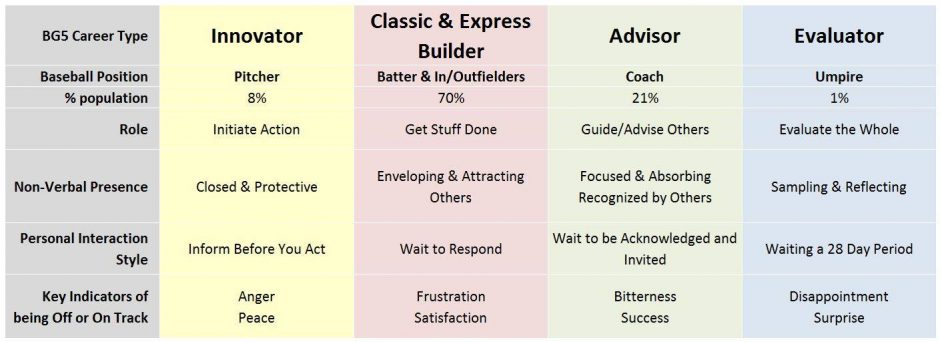The last part on the Reflector is nonsensical homogenization, and fantasy wishful thinking writing based on a theoretic understanding of Reflectors.
“Having clear boundaries and conscious awareness of what’s really going on during the game will help him not be overwhelmed by others or feel disappointed in the way the game is going but rather feel a sense of surprise and wonder at the excitement and flow of it all.”
Those pre-requisites of ‘having clear boundaries and conscious awareness’ are unattainable for any/all Reflectors and can not be used as a tool to counter such influences, this is just pretending to have any such control over the influence of the experience, first, and for all Reflectors, second. 7 centered Make-ability syndrome all over again.
Also as if being overwhelmed is something to avoid, first, and or bad, second, but most of all as if one actually can avoid any of the experience in such a way. But then also, as if ‘feeling a sense of’ [anything] is the goal! And then particularly or specifically “surprise and wonder at the excitement and flow of it all” as if Reflectors are toddlers or something, what the actual…?
Reflectors/Evaluators (still waiting for any proof that Ra himself ever called Reflectors Evaluators) do sample, do experience, but this way of writings suggests one only is one if one feels this sense of surprise and even wonder, first, but for the flow of it all? There is no room for things not flowing (say an accident happens with a player breaking a leg infield and needs medical attention, or a fight among players from opposing teams, or opposing fans), no room for unexcitement, which happens much MUCH more often than not and is just as valid an experience, especially when IT IS the actual experience of this, or that Reflector.
But also, as if 3 Reflectors, or 300 would experience all the same in the same situation, first, and only if they have clear boundaries and conscious awareness (can we measure this, is that in kilograms, or other units?) second.
Ah man… this is truly fantasy blabla-land.
Edit/add-on: it seems in BG5 there is no deconditioning and therefor something external must bring forth the peace, satisfaction, success and surprise (and wonder at the excitement and flow of it all), when living your design it is not brought (in/out?) by external factors, it is a result of you Living Your Design.
I can understand if one teaches things in certain ways, this is the conclusion people arrive at. And therefor surprise and awe/wonder happens because of this (positive thing only), or because of that (any other positive outer circumstance) because the teaching itself omits how it does work, so it does not sound too googoogaga, when in fact that is the -only- realm it does functions in: dark matter and dark energy.
And therefor has become yet another way of misrepresenting Reflectors and what they are and how they do work/function, when HD is probably the only tool available to explain Reflectors well, they seem to fucking miss the mark on each occasion.
MoonBlog 39.4
Gate 39 of the provocateur, obstruction. The value of obstruction in provoking analysis, assessment and reevaluation.
Gate 39 Line 4 Temperance (exalted) Careful evaluation and assessment before taking action.
Exalted: The values of feelings and instincts in establishing the proper timing. The energy to provoke at exactly the right time.
Detriment: The faulty belief that willpower alone can overcome any obstacle regardless of circumstances. The energy to provoke that ignores circumstances. The avoidance of confronting obstacles if failure puts others


BG5 Baseball: How to Play & Work True To Your Design
BG5 BUSINESS INSTITUTE·THURSDAY, 12 JULY 2018
Written by Kris Prochaska, MA
Sometimes folks get confused about how the different BG5 Types interact and get things done – especially in the workplace. In this baseball metaphor I’ll do my best to describe how the different types show up on the field of life – and work together to get things done.
To begin, let’s introduce our key players, the Career Design Types.

In the following metaphor think about the game in terms of a few things:
1. It’s not about the position specifically (in other words not all pitchers are Innovators)
2. We are looking at the ENERGETIC expression and communication of the types; it’s less about the concrete game of baseball, and more about the dynamics both intra-personally for each player, and inter-personally between the types.
3. For this example I’m not discerning between the Classic and Express Builder types, they are the majority of the population and therefore the majority on the field as well.

The Players:
The Innovator is like the pitcher. He starts the play by throwing the ball towards the batter (and catcher) both of which are the Builder types. The infielders and outfielders are also Builders. The coaches (both on the bench and near the first & third base) are Advisors, and our Umpire is the Evaluator.
How they play:
The Pitcher is the Innovator:

The Innovator, once he is ready based on his own decision-making strategy, throws the ball when it feels right (emotional clarity), or when he willfully determines he wants to (willpower), or when he intuitively knows it’s time (instinctive knowing).
He “informs” the other players of his intention to throw the ball through his stance on the pitcher’s mound and the nod he gives his catcher as they communicate through sign language about what pitch to throw. He then initiates the action of the game and gives the batter (Builder) something to respond to. His aura is repelling, much like the ball that is coming at the batter.
When the Innovator (Pitcher) doesn’t wait until he’s really ready to throw his pitch, or when he’s not liking the suggestions from his catcher or coach (because he wants to do what he wants to do), he may find himself getting angry –maybe at himself or at others on the field. Trusting himself and his timing for initiating is essential to feeling a sense of peace within – and this peace greatly impacts his accuracy and effectiveness on the mound.
The Batter is a Builder (as are the infielders & outfielders):

The batter waits in an active and receptive stance (as do the catcher & the other players on the field).
The Batter / Builder waits…
checking his gut (energy resource) or feeling (emotional clarity) for the right time to hit the ball – for the “right” pitch that energetically feels like the one to smack out of the park. This may take a while, and being patient and waiting for the right pitch is essential. The perfect pitch may not come when he’s up to bat, or he might get struck out – both of which are frustrating, but not the end of the world (even though as the Builder he may feel as though “nothing” is happening for him) in reality, it’s not true.
The Builder has an aura that is always drawing “balls” and things to respond to towards him, so if he is wildly swinging at everything that comes his way (and in this day and age, there are things coming from ALL directions!) then he might miss the perfect pitch, the one intended just for him that will give him the greatest return on his energetic output (i.e., a home run).
Wildly swinging at anything and not truly waiting for the pitch that most deeply resonates with his gut (or for some, emotional clarity) about which pitch “feels” right can cause a lot of frustration. This frustration is an indicator that the Builder is “off-base” (pun intended!) and needs to pause, regroup and get grounded in his sacral response again in order to respond to the pitch that feels “right” which brings a deep sense of satisfaction when the ball and bat connect and the ball soars into the outfield.

The in- and outfielders (also Builders) are all waiting in an active and receptive stance as well – ready to respond to whatever ball comes their way – whether that’s from the pitcher, or from another player on their team, and especially from the batter. The active and receptive stance is not just a physical action, it is all about energetic awareness and presence in the moment.
Some people think that “waiting to respond” is a passive activity, and the Builder is at the mercy of having to wait indefinitely. If you’ve ever watched kids play baseball you’ll know that the kids who are out there “picking daisies” and not paying attention or staying present to the game will often make mistakes and miss the ball when it comes their way – this also causes great frustration!
The Coach is the Advisor:

The baseline coaches will often have lots of hand symbols they use to communicate with the batter, catcher, etc. And even the bench coach will head out to the pitcher’s mound to talk with the pitcher if things aren’t going well. The thing about the coaches is this: if the players don’t look to or listen to the coaches (i.e., acknowledge or invite them to give direction and feedback), they won’t receive the advice the coaches are giving. And since the coaches are watching the larger play and dynamic of the game (through their absorbing frequency) vs. solely being focused on their own individual position in the moment (like the players) the players will miss out on the opportunity to improve or make necessary changes to be successful – both individually and as a whole team.
The Advisor (Coach) will use their instinctive knowing, emotional clarity, willful determination, mental reflection or inner knowing (the last two determined by what they hear themselves say), to make decisions about how to coach their players. They have the most diverse range of decision-making strategies of all the types, and can get derailed by the energy of the game or the lack of acknowledgement from their players, (among other things). This can cause bitterness, and perhaps even the emotional blow-ups that happen between the coaches and umpire when things aren’t going well or their recommendations aren’t recognized!
When the coach is acknowledged, seen, and even invited to impart their wisdom and big-picture view, they feel a deep sense of success and purpose. This internal sense of success is what allows them to be clear guides for others and give advice & coaching that brings out the best in all the players on the field.
The Umpire is the Evaluator:

The Umpire, or Evaluator, is gauging the entirety of the game – the fairness of play: which ultimately includes the energy and dynamics between the players, the coaches, and how everyone is doing on the field. They “sample” the energy and make calls based on what they see, feel, and perceive at the energetic level.
While the baseball Umpire has to make calls immediately on the field, the Evaluator best does this for himself over time (approx. 28 days following the lunar cycle). One might say it takes him several innings to have a real sense for how the game is going, and what call (choice/decision) to make about his own personal life.
When the Evaluator/Umpire is on the field and taking in (sampling) the energy of all the other players and the environment during the game, he’s very susceptible to being conditioned or influenced by the players, coaches, and fans. That said, in a healthy state he can walk off the field, go out to nature or be by himself for a while and release that conditioning more easily than others.
Having clear boundaries and conscious awareness of what’s really going on during the game will help him not be overwhelmed by others or feel disappointed in the way the game is going but rather feel a sense of surprise and wonder at the excitement and flow of it all.
The Fans in the Stands:

The fans could be thought of as the ancestral, social, cultural, and collective emotional & mental conditioning that happens around the players all the time. It’s the “white noise” that can either support them (through cheering) or bring them down (through booing), or distract them while they are on the field.
We can think of the fans and the other members of the team or organization as the tribe.
Helping the individual players recognize their own decision-making strategy (truth), skills, and unique gifts, and supporting them in expressing this truth and genius is part of the process of moving from a highly conditioned-and “prescribed” way of acting that keeps the individual “fitting in” (tribal paradigm) to a richer more purposeful and productive way of living and working.
This is a paradigm where the individual is allowed to bring all of him or herself to the game and is celebrated for it. They feel on purpose, and are way more engaged and effective when on the field.
BG5 Career Design Analysis provides a framework for deeply understanding the mechanics of the game of life and an individual’s role in it-personally and in relationship to others. When an individual understands their unique role (through their type, personal interaction style, and decision-making strategy) and they understand how they operate optimally based on their own design they begin to interact with and relate to the other types on the field in a synergistic way. The game flows and magic occurs as their innate strengths & gifts are released through play.
For You:
Based on your Career Design Type, imagine yourself on the field described above. If you know how others on your work team operate (i.e., their Career Designs) imagine them on the field with you. How does that change the way you perceive yourself and others in the game of life & work?
You may feel as though the game you’ve been playing has lasted for-e-ver! (Baseball sometimes feels that way). It’s never too late to re-assess your game and take a seventh inning stretch so to speak. Get familiar with your Career Design and how you best operate. You may or may not hit a home run right away, but chances that you will greatly increase and the game will certainly be a lot more fun!
Want to find out more about your Unique Career Design? Click to Receive a Free Report to learn more!

Kris Prochaska has 20+ combined years of experience as a therapist and business consultant which helps her laser right to the root of an issue and provide her clients effective and practical solutions. Maybe it’s because she prefers cowboy boots to heels, but she’s been described as an intuitive sharp-shooter who knows exactly what an individual or company needs to eliminate AND do more of in order to bring them into alignment for greater purpose, productivity, & profit. Her 2015 TED talk has over 150k views, and while she spoke about ‘how to get your kids to listen & engage’, the principles hold true in business as well. Kris is also a TEDx speaking coach and the author of Life Well Spoken: Free Your Inner Voice & Prosper. She is a BG5 Career Consultant in training. http://www.krisprochaska.com